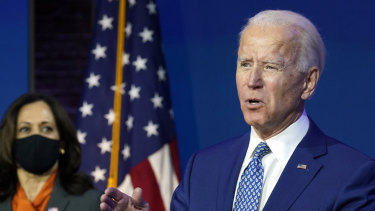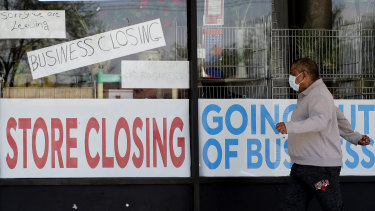‘Starting to see the cracks’: The US economy needs more than a $US900b plan to fix it
The economic recovery, slowing for months, is in danger of going into reverse. That's why a growing list of economists, business lobbyists and other advocacy groups are urging lawmakers to rally around the $US908 billion ($1.22 trillion) aid package currently gaining bipartisan support in Congress.
A plan of that size would fall short of doing everything that economists argue Congress should do to help workers and businesses during the coronavirus pandemic. But they said that if lawmakers could get the details right, Congress should do it anyway.
President-elect Joe Biden has implored Congress to reach a deal for more aid.Credit:AP
"It's within the range where you could argue it does enough good that it would be worth taking it," said William E. Spriggs, a Howard University economist who served in the Labor Department under President Barack Obama. "But it leaves a tonne on the table, and still leaves us with a big problem going forward."
The $US908 billion compromise is not even a legislative proposal yet. It is a bipartisan framework, assembled by a group of senators led by Republican Susan Collins, and Democrat Joe Manchin. Many of its details are still being negotiated, including how the government ought to distribute more aid to small businesses.
Once the bill is complete, its success is not assured: Senator Mitch McConnell of Kentucky, the majority leader, has stopped short of endorsing it, and so has President Donald Trump, who would need to sign any legislation approved in the lame-duck congressional session. But Speaker Nancy Pelosi of California has backed it as a starting point for renewed negotiations, and President-elect Joe Biden said on Friday (US time) that he was "encouraged" by the effort.
Experts say the plan would provide relief to several battered corners of the economy. It includes nearly $US300 billion for small-business aid, $US180 billion for unemployed workers, and $US160 billion for state, local and tribal governments.
The plan wouldn't help everyone who needs aid, and the support might not last long enough to bridge the economy to the rebound that is expected to come when coronavirus vaccines are widely distributed. And much depends on the details, particularly when they come to Americans who have been unemployed for months and small businesses that struggled to tap government programs early in the pandemic.
But if the plan was passed soon, it would send money out quickly. And with virus cases rising and economic gains stalling, a growing number of politicians are willing to accept such a compromise.
"You get most of the way there, you don't turn around at the end," said Governor Mike DeWine of Ohio, one of several Republican governors who has called for more federal aid. "We can't stop now, and I guess I would say that to my friends in Congress: We need your help one more time here. Help get us through what's going to be a very tough winter."
November employment data released by the Labor Department on Friday underscored his point. Job growth slowed to 245,000, the weakest monthly gain of the recovery so far. The number of people trapped in long-term unemployment rose to nearly 4 million. Restaurants and retailers, whose rehiring of furloughed workers helped power the rebound in earlier months, cut jobs in November. The number of people who have lost their jobs permanently rose, the latest sign that the crisis will leave lasting economic scars.
Biden warned that lawmakers would need to spend more once he took office. "The country's going to be in dire, dire, dire straits if they don't," he said.
"I do feel a greater sense of urgency now, especially after seeing the jobs report," said Karen Dynan, a Harvard economist and former Treasury Department official in the Obama administration. "We're really starting to see the cracks now."
Perhaps the top goal for the aid package is preventing millions of families from losing their only source of income the week after Christmas.
As many as 13 million Americans are receiving benefits under two programs that expanded and extended the existing unemployment insurance program. Those programs, created by Congress in the spring, are set to expire at the end of the year — an outcome that members of both political parties have said they want to avoid.
The aid package being discussed in Congress would extend both programs, while also reviving the extra unemployment benefit that expired over the summer, most likely at half the original $US600-a-week level. But depending on how the negotiations go, it may not further extend eligibility for people who are close to the end of their benefits already.
There has been a partial recovery in the US economy, but President-elect Joe Biden faces high unemployment and crippling budget deficits.Credit:AP
Putting money into the pockets of the unemployed could be good for the broader economy: Research has found that unemployment benefits are among the most effective forms of economic stimulus because recipients are likely to spend rather than save the money. And by helping families avoid foreclosures, evictions and debt defaults, unemployment benefits can prevent the financial damage from spreading.
But the most compelling argument may be not economic but humanitarian: Without the money, many families could go hungry, become homeless and face other hardships.
"If households are in financial catastrophe, then we have a moral obligation as a country to help households regardless of what their spending or not spending does to the aggregate economy," said Wendy Edelberg, director of the Hamilton Project, an economic policy arm of the Brookings Institution.
Money in the proposal would similarly provide a lifeline to some small businesses that risk closing for good amid weak demand between now and when vaccines become available. Even large companies could be hurt if many smaller firms go under, which is one reason large business groups have called for immediate aid to small companies.
The deal would provide money to state and local governments, though the $US160 billion being discussed is a small fraction of the $US1 trillion that Democrats initially proposed last spring.
State and local aid has been a major sticking point in negotiations, with McConnell dismissing it as a "blue-state bailout." But Republican-led states face some of the biggest revenue gaps.
States and local governments, which have been battered by pandemic-related costs and collapsing tax revenues, have already cut more than 1.3 million jobs, and much deeper cuts loom. Those cuts could have both short- and long-term consequences. A new round of public-sector layoffs and furloughs, combined with slowing private-sector hiring, could derail the precarious recovery. And cuts to schools, public transportation and other services could make it harder for the economy to regain momentum once the pandemic has passed.
Even if Congress does reach a deal before the end of the year, Biden warned on Friday that lawmakers would need to spend more once he took office. "The country's going to be in dire, dire, dire straits if they don't," he said.
The New York Times
Business Briefing
Start the day with major stories, exclusive coverage and expert opinion from our leading business journalists delivered to your inbox. Sign up for the Herald‘s here and The Age‘s here.
Most Viewed in Business
Source: Read Full Article



